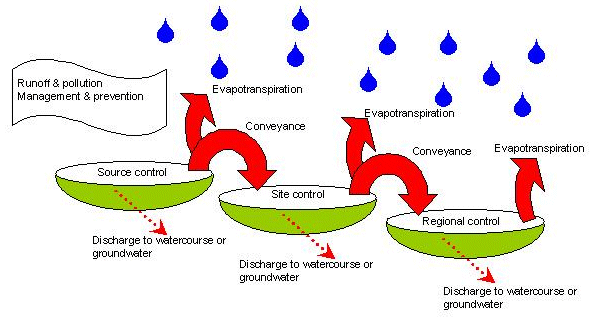

SuDS-related links
Keeping ahead
with SuDS
Attend SuDS training to keep ahead of the competition and to deliver innovative solutions in line with recognised good practice.
home > using suds > principles
Sustainable drainage is a departure from the traditional approach to draining sites. There are some key principles that influence the planning and design process enabling them to mimic natural drainage by:
A useful concept used in the development of drainage systems is the surface water management train, illustrated below. Just as in a natural catchment, drainage techniques can be used in series to change the flow and quality characteristics of the runoff in stages.

The management train starts with prevention (preventing runoff by reducing impermeable areas), or good housekeeping measures for reducing pollution, for individual premises; and progresses through local source controls to larger downstream site and regional controls. Runoff need not pass through all the stages in the management train. It could flow straight to a site control, but as a general principle it is better to deal with runoff locally, returning the water to the natural drainage system as near to the source as possible. Only if the water cannot be managed on site should it be (slowly) conveyed elsewhere. This may be due to the water requiring additional treatment before disposal or the quantities of runoff generated being greater than the capacity of the natural drainage system at that point. Excess flows would therefore need to be routed off site. End of pipe solutions where runoff is direclty discharged to a wetland or pond should be avoided.
SuDS design requires a balancing of different options, often depending on the risks associated with each course of action. The risks of an area flooding have to be balanced with the costs of protecting the area from different levels of floods.
The management train concept promotes division of the area to be drained into sub-catchments with different drainage characteristics and land uses, each with its own drainage strategy. Dealing with the water locally not only reduces the quantity that has to be managed at any one point, but also reduces the need for conveying the water off the site.
When dividing catchments into small sections it is important to retain a perspective on how this affects the whole catchment management and the hydrological cycle.
Source controlDealing with water when and where it falls (source control) may be the preferred, cheaper and easier option for many developments. Source control is more appropriate in urbanised areas where space may be at a premium and less readily available. By dealing with runoff at the source the volume of water and the potential amount of contamination is less, which requires smaller SuDS components further downstream. Often source control components are within the curtilage of properties and maintained by the property owner or manager and can include green roofs, permeable surfaces, rainwater harvesting etc. |
Where ever possible runoff from developments should be managed on the surface. This enables their performance to be more easily inspected and managed with pollution incidents and potential flood risk being visible. Managing water on the surface can also greatly improve the quality of place by integrating water features into the development, this can either be through soft or hard landscaping.
Managing water on the surface also encourages natural breakdown of some pollutants and can allow easier adaptation to climate change and other developmental pressures.
SuDS should be seen in the context of other surface water management approaches, including flood routing, the management of extreme events where the rainfall exceeds the capacity of the drainage system (drainage exceedance) and the opening of urban channelised watercourses (culverts).
Drainage systems considered at the earliest stages of site selection and design are easier to integrate into developments influencing other aspects of the site (ie design, layout and function) and reducing impermeable areas wherever possible.
Successful designs need to consider local policy documents developed by the Local Planning Authority and should take into account the Local Flood Risk Management Strategy, and associated documents.
Effective early engagement with stakeholders should also help deliver SuDS in multi-functional spaces such as car parks, footpaths and verges, gardens, landscaped areas, driveways, courtyards or communal spaces. This should improve cost effectiveness and integration within the development producing better places to live.